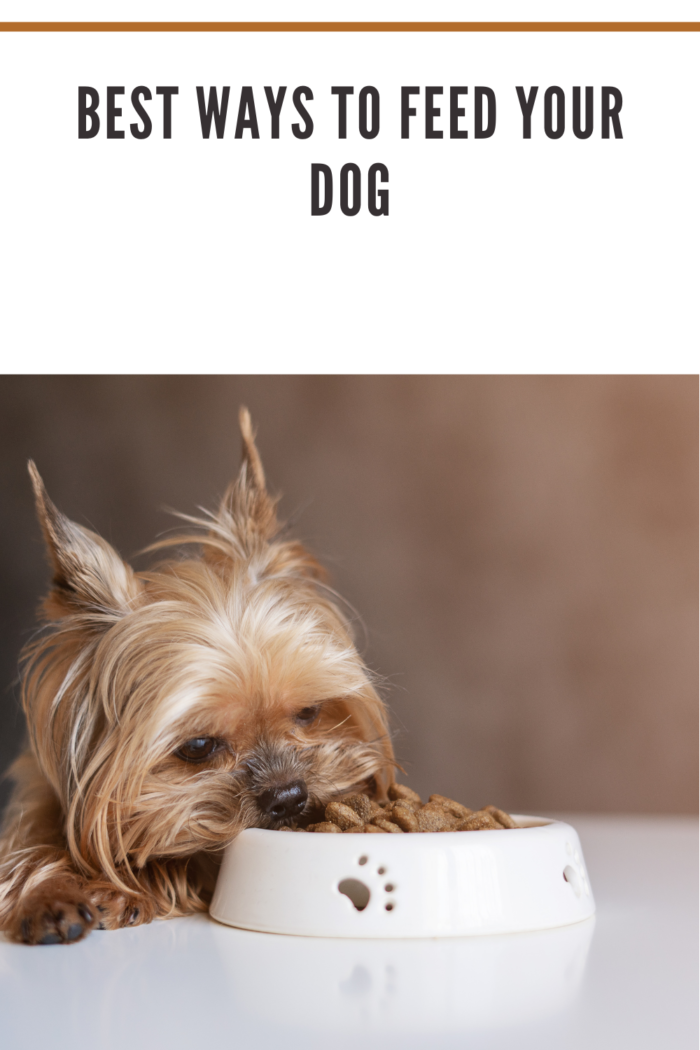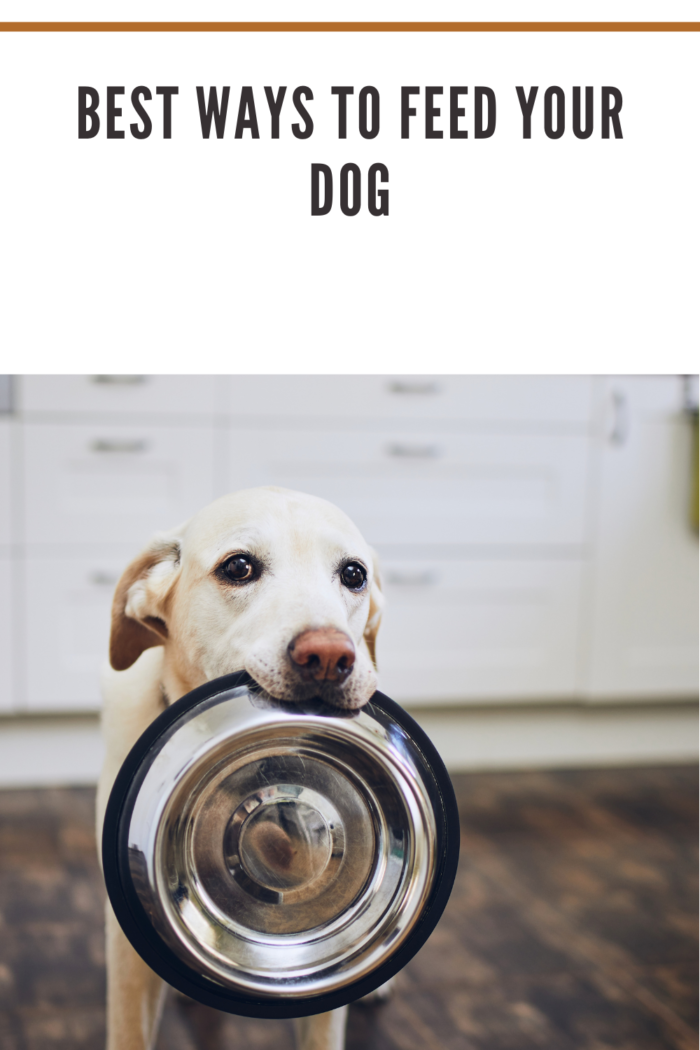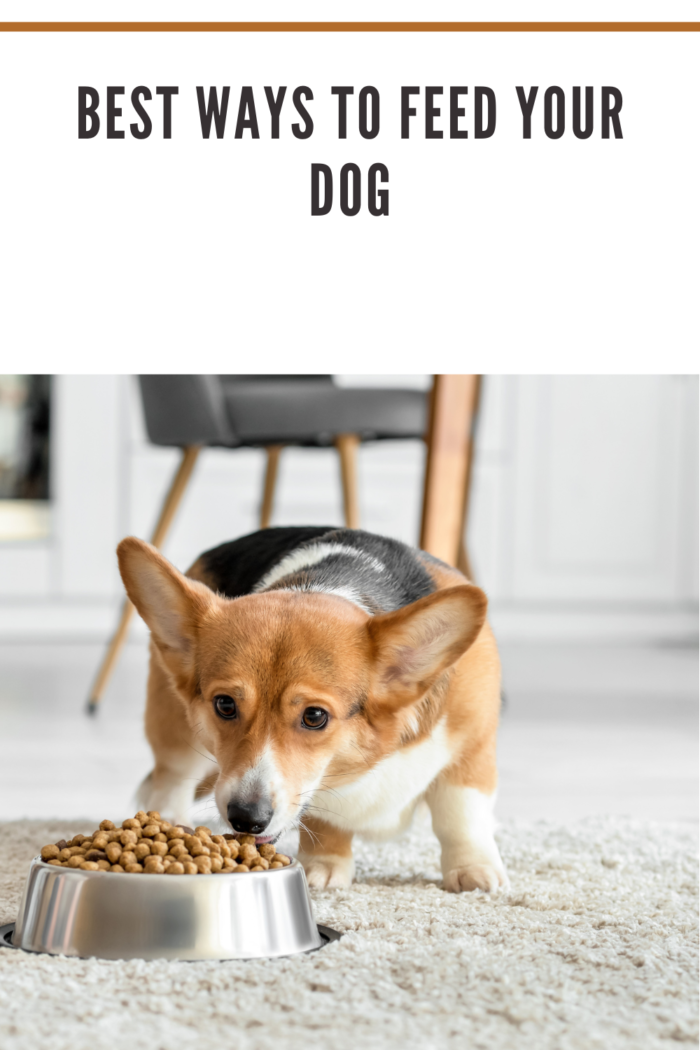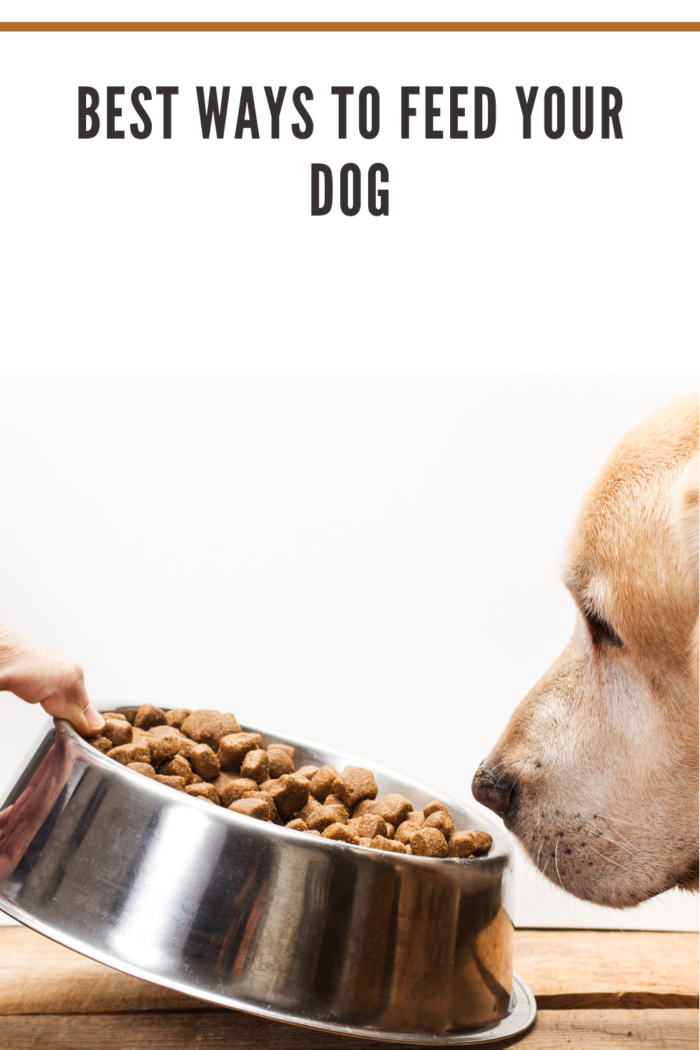Discover the best ways to feed your dog for optimal health and happiness. From nutrition tips to feeding routines, find expert advice for your furry friend.
Owning a dog is a great treat. Just remember that you will be responsible for every aspect of your dog’s life. If they do not get sufficient food or enough nutrients, you can guarantee that there will be problems ahead. You need to ensure that your dog is eating healthy foods, which can be much harder than most people could ever imagine. So, what are the best ways to feed your dog? Which foods are recommended? You’re going to find the answers in the guide below.
Best Ways to Feed Your Dog
Unique Dogs
First and foremost, you should know that every dog is unique. Some have very strong stomachs, and they can eat pretty much anything. Other dogs have stomach sensitivities, and that will make it much more difficult to find suitable foods for them. To find out what is going to be right for your dog, you need to learn more about their health. Are they suffering from any food sensitivities? If so, you need to find out what they are so you can avoid giving your dog foods that will cause additional problems.
Understanding your dog is unique is a tip for the best way to feed your dog because every dog has its own individual needs, preferences, and dietary requirements. Dogs come in different breeds, sizes, ages, and health conditions, which can greatly influence their nutritional needs.
By understanding your dog’s unique characteristics, you can tailor their feeding routine to meet their specific requirements. This includes factors such as their age, weight, activity level, metabolism, and any specific health concerns they may have. For example, a small breed dog may have different caloric needs compared to a large breed dog, and a senior dog may require a diet that supports joint health.
Furthermore, understanding your dog’s preferences can help ensure they enjoy their meals and maintain a healthy appetite. Some dogs may have specific tastes or dietary sensitivities, and being aware of these preferences allows you to select appropriate and appealing food options.
Additionally, understanding your dog’s behavior and body language can help you establish a feeding schedule and portion sizes that work best for them. Dogs may show signs of hunger or fullness, and being attentive to these cues can prevent overfeeding or underfeeding.
In summary, recognizing and understanding the unique characteristics of your dog allows you to customize their feeding routine, choose appropriate food options, and ensure they receive the nutrition they need for optimal health and well-being.

Homemade
According to Carlotta, bloating in dogs is more common than most people imagine. Bloating is often caused when the owner gives their dog the wrong food. With that being said, it might be best to make the switch to homemade foods. This is going to be harder on your end. However, you’ll have complete control over the situation. You’ll be able to find foods that are going to match your dog’s health, breed, and lifestyle. If you want to make sure that your dog is being fed in the best way possible, you’ll want to make your own dog food. Just remember that it is not going to be easy at all.
Homemade dog food can be considered one of the best ways to feed your dog for several reasons:
- Control over ingredients: When you prepare homemade dog food, you have full control over the quality and selection of ingredients. You can choose high-quality, fresh ingredients and avoid additives, preservatives, and fillers that may be present in commercial dog food. This allows you to provide a healthier and more natural diet for your dog.
- Customization: Homemade dog food allows you to tailor the diet to meet your dog’s specific needs. You can accommodate dietary restrictions, allergies, or sensitivities by avoiding ingredients that may trigger adverse reactions. Additionally, if your dog has unique nutritional requirements or specific health conditions, such as obesity or kidney disease, you can customize the recipe accordingly.
- Freshness and quality: By preparing homemade dog food, you can ensure the freshness of the ingredients used. Fresh food retains more nutrients compared to processed commercial options that may undergo high-heat processing or have long shelf lives. This can contribute to improved overall health and well-being for your dog.
- Increased variety: Homemade dog food allows for a greater variety of ingredients and flavors. Dogs, like humans, can get bored with repetitive diets. By providing a diverse range of ingredients, you can keep your dog interested in their meals and potentially reduce the risk of developing food allergies or intolerances due to prolonged exposure to the same ingredients.
- Bonding and involvement: Preparing homemade dog food can be a bonding experience between you and your dog. It involves hands-on preparation and allows you to be directly involved in your dog’s nutrition. This can strengthen the bond between you and your pet while ensuring their meals are made with love and care.
While homemade dog food can have numerous benefits, it’s important to note that it requires proper knowledge and understanding of canine nutrition. Consultation with a veterinarian or a veterinary nutritionist is recommended to ensure that the homemade diet is balanced, provides all necessary nutrients, and meets your dog’s specific requirements.
Additionally, it’s crucial to maintain hygiene standards and handle food safely to avoid the risk of bacterial contamination. Improperly prepared homemade diets can lead to nutritional deficiencies or imbalances, so it’s important to educate yourself on the nutritional needs of dogs and follow appropriate recipes or guidelines.

Small Things Matter
When it comes down to it, the small details matter here. You might think that it is a good idea to feed your dog just once a day. This might not be the case at all. Dogs that only eat once a day will be more likely to develop extra stomach acids (PetMD). That could cause vomiting. With that being said, it is vital to pay close attention to the small details. Try feeding your dog at least twice a day to avoid potential problems. Feeding your dog more often can help. Just make sure that you do not overdo it and cause your dog to gain too much weight.
The tip “small things matter” when it comes to feeding your dog emphasizes the significance of paying attention to the little details in your dog’s diet.
Here’s why it is considered one of the best ways to feed your dog:
- Portion control: Proper portion control is essential for maintaining a healthy weight in dogs. Feeding your dog appropriate portion sizes based on their size, age, activity level, and metabolism helps prevent overfeeding, which can lead to obesity and related health issues. By being mindful of portion sizes, you can ensure your dog receives the right amount of food to maintain an ideal body condition.
- Treats and snacks: Small treats and snacks given throughout the day can quickly add up in terms of calories. Many dog owners may unintentionally overindulge their pets with treats, which can contribute to weight gain. Paying attention to the quantity and nutritional content of treats is crucial. Opt for healthier treat options or even consider using small portions of your dog’s regular food as rewards.
- Food quality: Even small differences in the quality of ingredients can have an impact on your dog’s overall health. Opting for high-quality dog food made with nutritious ingredients can provide essential nutrients, promote better digestion, and support your dog’s overall well-being. Reading labels and choosing reputable brands that prioritize quality ingredients is vital.
- Mealtime routines: Establishing a consistent feeding routine can be beneficial for dogs. Dogs thrive on predictability, so feeding them at the same time each day helps regulate their metabolism and digestion. Additionally, providing a calm and quiet environment during mealtimes can reduce stress and allow your dog to focus on eating without distractions.
- Hydration: Adequate hydration is crucial for your dog’s health. While it may not directly relate to feeding, ensuring access to fresh water at all times is essential. Small things like regularly changing the water, cleaning the water bowl, and monitoring your dog’s water intake can contribute to their overall well-being.
- Observing dietary changes: Paying attention to how your dog responds to different types of food can help identify any sensitivities or allergies they may have. If you notice any adverse reactions or digestive issues after introducing new foods, it’s important to make adjustments accordingly.
By focusing on these small details, you can optimize your dog’s nutrition, maintain their health, and prevent potential problems related to their diet. Consistency, portion control, food quality, hydration, and awareness of your dog’s individual needs all play a significant role in providing them with the best possible nutrition.

Wet Or Dry
Finally, you should choose a wet or dry food for your dog. In this category, it doesn’t matter. Some dogs will prefer wet foods, but others will like dry foods. So, which one is best? There is no correct answer here. The truth of the matter is that both types of food can be very nutritious. As long as you choose one that is going to provide your dog with all of the nutrients that he or she needs, you’ll be just fine.
The choice between dry and wet dog food depends on various factors and should be based on your dog’s individual needs, preferences, and any specific health considerations.
Both dry and wet dog food options have their own advantages and considerations:
Dry Dog Food:
- Convenience: Dry dog food is generally more convenient to store, serve, and handle. It has a longer shelf life and doesn’t require refrigeration once opened.
- Dental Health: The crunchy texture of dry dog food can help promote dental health by reducing tartar and plaque buildup through the mechanical action of chewing.
- Cost-effective: Dry dog food tends to be more cost-effective than wet food, especially when considering larger breeds or long-term feeding.
Wet Dog Food:
- Moisture Content: Wet dog food has a higher moisture content, which can help keep your dog hydrated, especially if they don’t drink enough water. It can be particularly beneficial for dogs with urinary or kidney issues.
- Palatability: Many dogs find wet dog food more palatable due to its softer texture and stronger aroma. This can be helpful if your dog is a picky eater or has a decreased appetite.
- Digestibility: Wet dog food is generally easier to digest, making it suitable for dogs with sensitive stomachs or gastrointestinal issues.
- Variety: Wet dog food often comes in a wide range of flavors and textures, providing more variety and options to entice your dog’s appetite.
It’s important to note that both dry and wet dog food can provide complete and balanced nutrition if they meet the required standards and guidelines. The best choice for your dog will depend on factors such as their age, size, breed, dental health, any specific dietary needs or allergies, and your veterinarian’s recommendations.
Some dog owners also opt for a combination feeding approach, where they provide a mix of dry and wet food, or they may alternate between the two. This can offer the benefits of both types of food while adding variety to your dog’s diet.
Ultimately, it’s advisable to consult with your veterinarian to determine the most suitable type of food for your dog based on their specific needs and any health considerations they may have.

Final Thoughts:
Feeding your dog is an essential aspect of their overall health and well-being. It’s important to prioritize their nutritional needs, preferences, and any specific dietary considerations they may have.
Here are some final thoughts to keep in mind:
- Consult with a veterinarian: Your veterinarian is a valuable resource when it comes to understanding your dog’s nutritional requirements. They can provide guidance on choosing the right type of food, portion sizes, and any specific dietary considerations based on your dog’s age, breed, size, health conditions, and individual needs.
- Quality matters: Opt for high-quality dog food that meets industry standards and provides the necessary nutrients your dog requires. Read labels, research brands, and choose options that prioritize wholesome ingredients without unnecessary additives, fillers, or artificial preservatives.
- Balance and variety: Strive for a balanced diet that includes a variety of nutrients. This can be achieved through a combination of high-quality commercial dog food, homemade meals prepared with guidance from a veterinarian or veterinary nutritionist, and appropriate treats. Providing a diverse range of ingredients helps ensure your dog receives a wide spectrum of nutrients.
- Portion control and monitoring: Pay attention to portion sizes and adjust them based on your dog’s age, size, activity level, and body condition. Regularly monitor your dog’s weight and body condition to ensure they are maintaining a healthy weight. Avoid overfeeding or underfeeding.
- Hydration and water accessibility: Ensure your dog has access to fresh water at all times to stay properly hydrated. Regularly clean and refill their water bowl.
- Observe and adapt: Pay attention to your dog’s behavior, body condition, digestion, and overall health. If you notice any changes, consult with your veterinarian to determine if adjustments to their diet or feeding routine are necessary.
Remember, every dog is unique, and their nutritional needs may vary. By understanding and addressing their specific requirements, you can provide them with the best possible diet to support their overall health and happiness.

